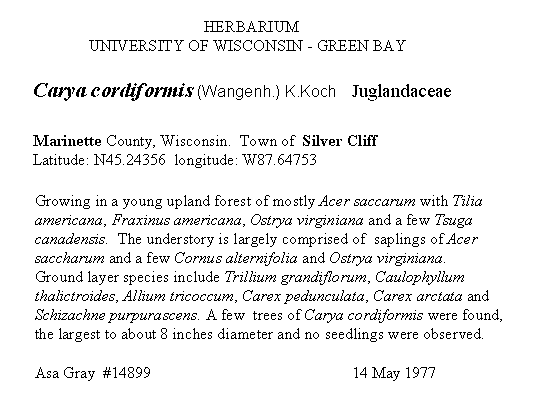
Labels for herbarium vouchers
| Labels for vascular plant vouchers vary among the various herbaria, but the essential components are predictable. At a minimum each label must include the scientific (Latin) name for the plant, the location at which the plant was collected, the date of collection and the collectors name. Typically the label would also include a description of the habitat and associated species, an estimate of the plant's status at that site and a collector number. If the collector should misidentify the plant, the voucher can thereafter be examined by a knowledgeable botanist and the correct identity is then written on the voucher sheet in the process known as annotation. |  |
|
| Typically, collectors press the plants in newspaper.
Some local "shopper" newspapers, etc may be nearly the correct
size for this purpose. Regular newspapers can be cut to about 18 x 12 inches.
The plants must fit in this size because they must fit on a standard sized
sheet of paper (16.5 x 11.5) in the collection . Specimens collected for
vouchers must include plants or plant parts sufficient to reliably identify
the voucher. For many plants that requires flowers and/or fruit, but for
trees it is often possible to make a good voucher from mature leaves attached
to a twig -- winter buds are also helpful and will be fully formed by
mid to late July and extending throughout the next winter. September is
a very good time to collect vouchers of many deciduous trees. As you gain
experience in identifying the plants, you will learn what characters are
necessary to identify them, and can therefore collect the vouchers accordingly.
Many collectors choose to assign a unique collector number to each specimen, usually beginning with 1, 2, 3 etc. and continuing for their entire career. The number can then be used in your field notes to keep track of the data pertaining to each voucher, and that same number can be written on the newspaper in which the plant is pressed to keep the specimen connected to the information. Taking and keeping good field notes is essential for those working in natural resources fields. It has been my experience that the information may also be important years later and for purposes not initially intended. Most herbaria prefer to mount the vouchers themselves. We use a special
kind of paper that is designed to last for a very long time and to resist
changes in color and consistency of the paper. The glue is also chosen
specifically for the making of herbarium vouchers and we print labels
on archive-quality paper with permanent ink. Our preferred method is
to receive each pressed and dried plant in the newspaper it was dried
in, with the label or the label information on a separate sheet inside
the newspaper. Fifteen or twenty such sheets can be stacked, and then
sandwiched between two pieces of heavy cardboard and snuggly wrapped
and tied with string, or by taping the edges of the cardboard securely
together to hold the plants securely and keep any parts from falling
out. They can be mailed in this fashion, with several bundles together
in a box if there are more plants. |
||